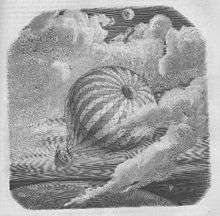The Unparalleled Adventure of One Hans Pfaall
| "The Unparalleled Adventure of One Hans Pfaall" | |
|---|---|
| Author | Edgar Allan Poe |
| Country | United States |
| Language | English |
| Genre(s) | Science fiction, hoax |
| Publisher | Southern Literary Messenger |
| Media type | Print (periodical) |
| Publication date | June 1835 |
"The Unparalleled Adventure of One Hans Pfaall" (1835) is a short story by Edgar Allan Poe published in the June 1835 issue of the monthly magazine Southern Literary Messenger, and intended by Poe to be a hoax.
Poe planned to continue the hoax in further installments, but was upstaged by the famous Great Moon Hoax which started in the August 25, 1835 issue of the New York Sun daily newspaper. Poe later wrote that the flippant tone of the story made it easy for educated readers to see through the supposed hoax.
Plot summary

The story opens with the delivery to a crowd gathered in Rotterdam of a manuscript detailing the journey of a man named Hans Pfaall. The manuscript, which comprises the majority of the story, sets out in detail how Pfaall contrived to reach the moon by benefit of a revolutionary new balloon and a device which compresses the vacuum of space into breathable air. The journey takes him nineteen days, and the narrative includes descriptions of the Earth from space as well as the descent to its fiery, volcanic satellite. Pfaall withholds most of the information regarding the surface of the moon and its inhabitants in order to negotiate a pardon from the Burgomaster for several murders he committed as he left earth (creditors of his who were becoming irksome). After reading the manuscript, the city authorities agree that Pfaall should be pardoned, but the messenger who brought them the text (apparently a resident of the moon) has vanished and they are unable to restore communication with him.
Literary significance
Poe's story may have had an influence on, and is referenced in Jules Verne's From the Earth to the Moon, which seems to be a retelling of the story.[1] Poe later published a similar hoax, "The Balloon-Hoax", in the New York Sun.
See also
References
External links
 The full text of The Unparalleled Adventure of One Hans Pfaall at Wikisource
The full text of The Unparalleled Adventure of One Hans Pfaall at Wikisource- Publication history and versions of "Hans Pfaall"
-
 The Works of Edgar Allan Poe, Raven Edition, Volume 1 public domain audiobook at LibriVox
The Works of Edgar Allan Poe, Raven Edition, Volume 1 public domain audiobook at LibriVox